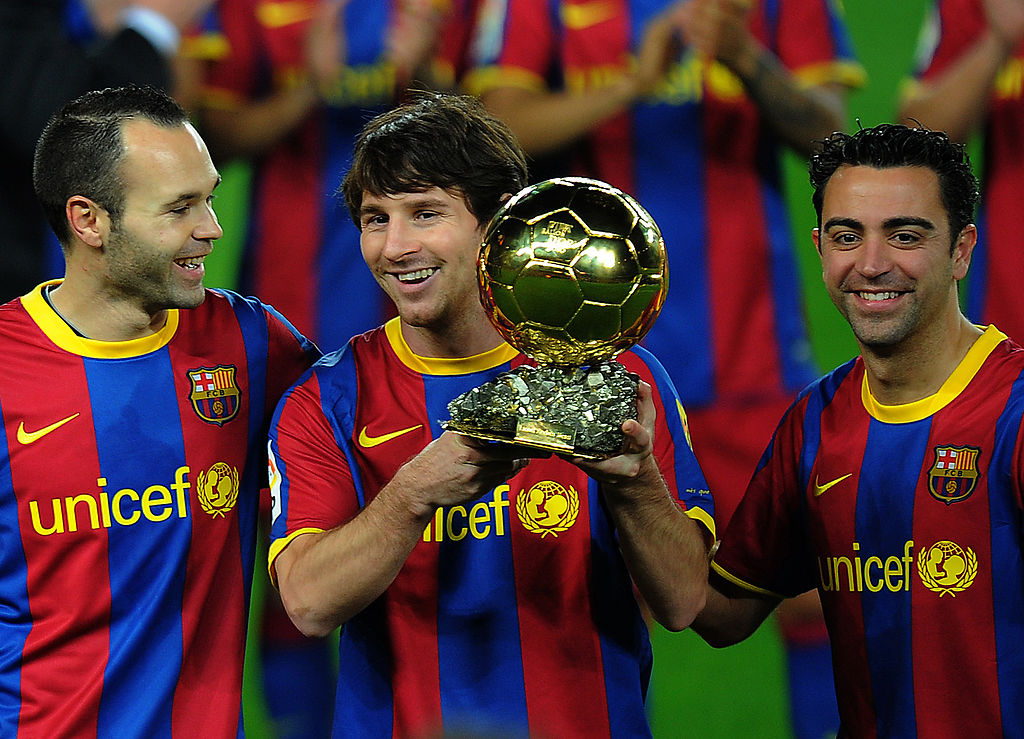Happy 30th anniversary, FourFourTwo: The story of the ‘quite remarkable’ football magazine
Three decades ago when FourFourTwo launched, no-one imagined it would lead to an all-nighter with Delia Smith, being abducted by an Israeli taxi driver and sending Bobby Robson bottles of HP Sauce through the post. We speak to every previous editor, to hear the full story of the ‘quite remarkable’ football magazine
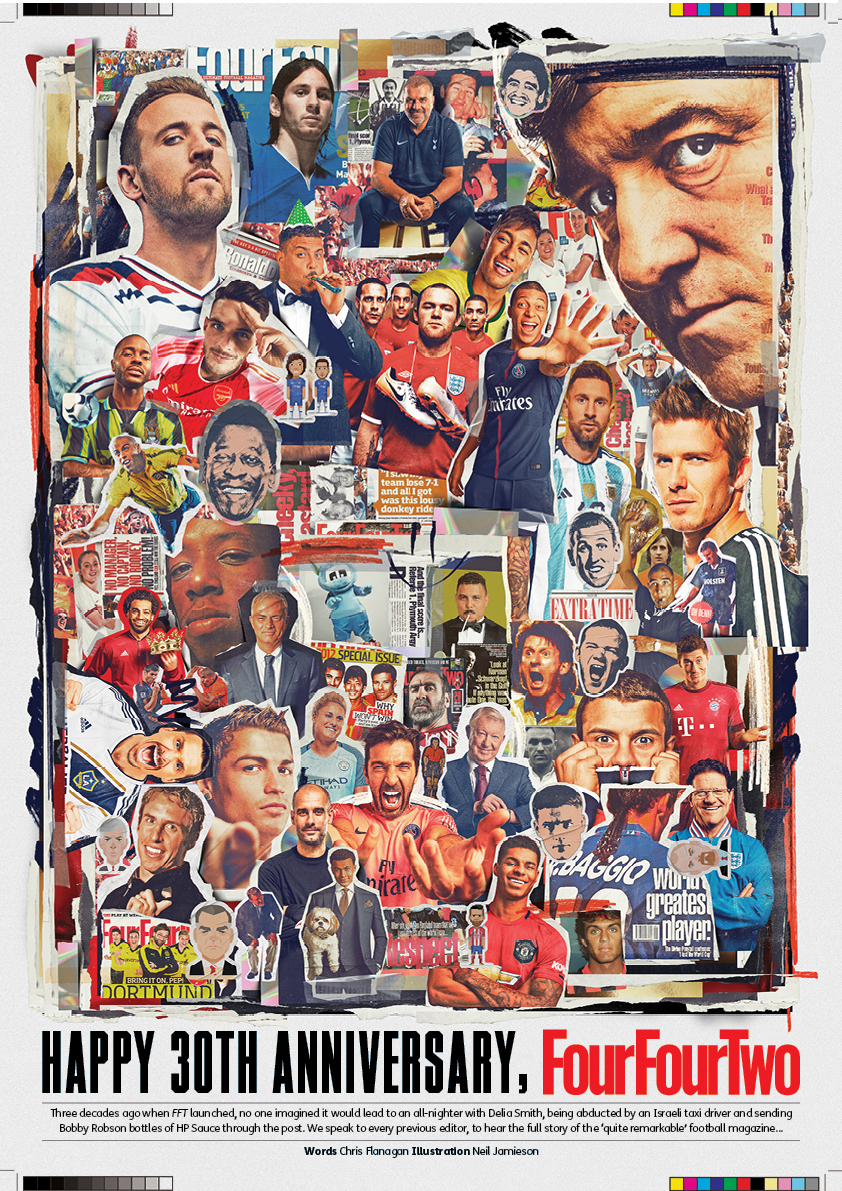
Zinedine Zidane still had a full head of hair as he emerged from the bench in Bordeaux, for his France debut in 1994.
Within minutes, the 22-year-old picked up the ball midway into the opposition half, bamboozled one Czech Republic player with a stepover, sidestepped another, then hammered a left-foot shot into the top corner from 25 yards. Two minutes later, he rescued a 2-2 draw by heading home a corner, foreshadowing his famous brace in the 1998 World Cup final.
Zizou had arrived, and he wasn’t alone in shooting to prominence that day. Hours earlier, on the other side of the English Channel, the very first issue of FourFourTwo magazine had launched, with a similar mission to entertain – granted, we’re yet to win the World Cup and four Champions Leagues like the great Zidane, but neither have we headbutted someone in front of a TV audience of 715 million people, so swings and roundabouts.
The story of FourFourTwo
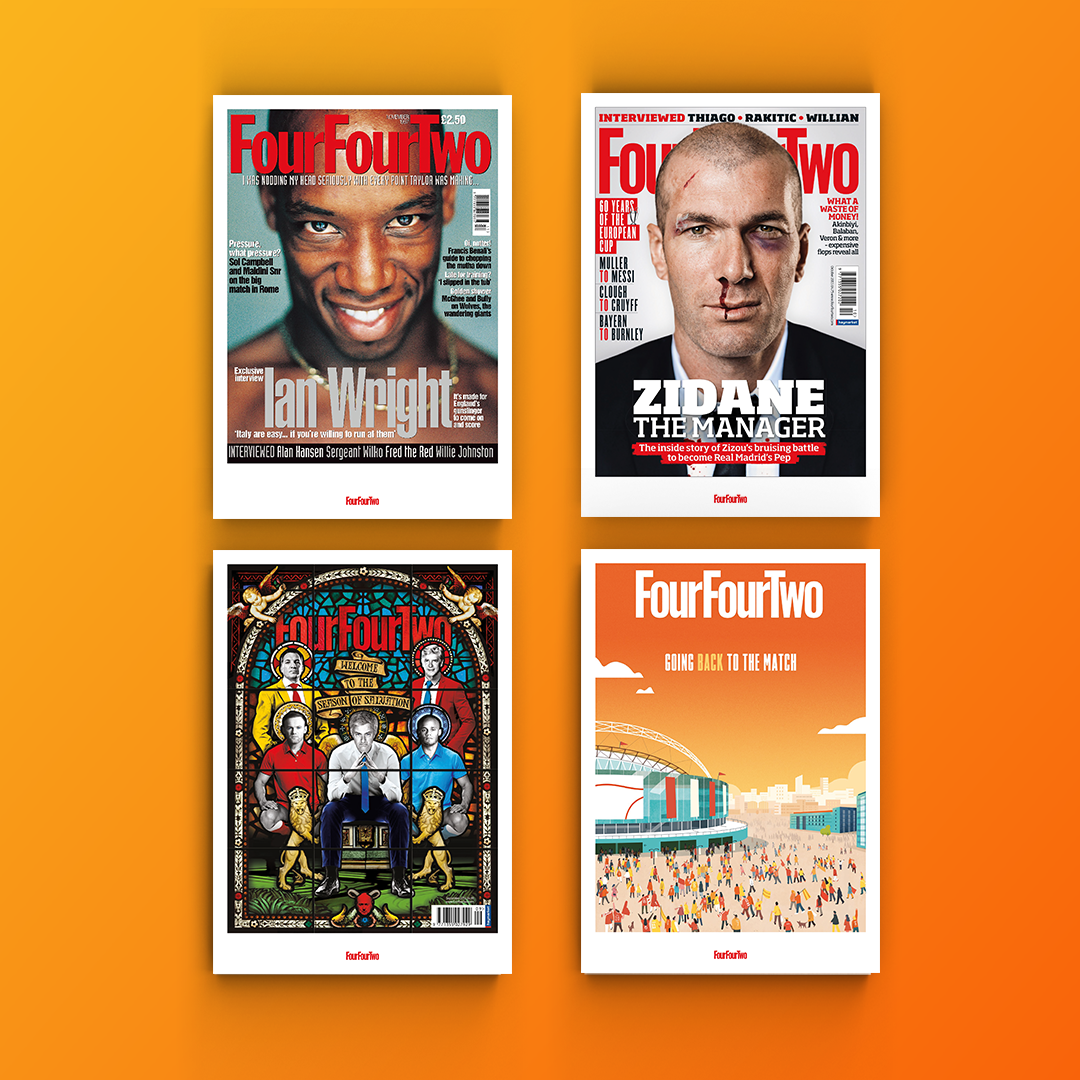
Launching a new football magazine in the UK might have seemed counterintuitive in 1994, shortly after the only World Cup without any British involvement since 1938. But football was changing – the Premier League had just begun, Sky Sports had burst on to the scene with its tagline ‘A whole new ball game’, stadiums were starting to be modernised, and both Fantasy Football League and Gazzetta Football Italia were gaining cult followings on TV.
The idea for a new monthly publication came from a staff member at Wine and Spirit International, part of the Haymarket Media Group. “I went to my boss at Haymarket and said ‘I’d like to launch a football magazine’,” Norwich City fan Karen Buchanan explains now. “In the 1980s, you’d had the Heysel and Hillsborough disasters, and a perception of football being full of hooligans.
“But I’d fallen in love with football at Italia 90, because of England and the brilliance of Gazza – I wanted something that reflected my interest in it, about the conversations you had with your mates at the pub. At the time, you weren’t reading about that passion, that love of the game. You had magazines for kids, or you had the newspapers.”
At a pub in Teddington in south west London, Buchanan discussed her idea with Haymarket’s development publisher Simon Kanter. “When you told me it’s the 30th anniversary, that was just about the scariest thing I’ve ever heard – it seems like yesterday,” he chuckles.
Get FourFourTwo Newsletter
The best features, fun and footballing quizzes, straight to your inbox every week.
“Karen pitched her idea and I liked it – the premise was taking the spirit of what fanzines were doing, and adding an extra level of glamour. I support Spurs and thought ‘Yeah, I want to do this, but how the hell am I going to do it, when it’s not the brief of my job?’ My job was to get Haymarket back into computer magazines.
“I decided to do it in secret. We were creating a product called Windows Professional, aimed at users of the Windows NT computer system – whenever the bosses left the office, we changed everything around to football content. I had two names, FourFourTwo, which was a trendy formation, or One Nil, David Coleman’s famous expression when a goal was scored.
“We made a dummy magazine – Kevin Keegan was on the cover, so I went to Newcastle to see how a focus group there would react. I was blown away – they said ‘This is brilliant, we’d all buy it’. Other secret research said the same. Then we had to tell the business, and persuade them to let us launch it.
“There was a board meeting with the managing director Simon Taylor, who was also BBC Radio 5 Live’s Formula 1 commentator. One by one, the board knocked our idea down. One said ‘FourFourTwo? Nobody will know what that means, why don’t you call it Football Magazine?’ Another said ‘This won’t work’. It finally came to Taylor, and he said ‘Well I don’t know what’s the matter with you all, I think it’s f**king brilliant’.”
Blessed by Kevin Keegan

The magazine got the go-ahead. “I became the founding editor, or as my business card said, the ‘pounding editor’, because it was misprinted,” Buchanan laughs. “One of our first stories was ‘Barry Fry, cheeky fat bastard’ – for the interview, I went out for dinner with him on the Friday night before a game. He was good and said ‘If we win tomorrow, you’ll have to meet me every Friday night’. The day after, his Birmingham team were winning until about the 85th minute – I thought ‘Shit, I’m going to have to meet Barry Fry on Friday nights for the rest of my life!’”
Leicester fan Paul Simpson was brought in as launch editor, to run the magazine. “Some people didn’t think football fans could read, but we wanted it to be a proper read that was entertaining, thought-provoking and knowledgeable,” he says. “My main memory of the first issue was the working hours – it was a hell of a lot of work...”
Also recruited were writers Olivia Blair and Amy Lawrence, who’s since gone on to a distinguished career with the Guardian, the Observer and the Athletic. “I’d seen an advert in the Guardian’s job pages saying ‘Football writers wanted for book project’ – the actual job was disguised,” Lawrence says. “As a young football-loving English graduate who was delivering leaflets and working in pubs, I sent off my CV with zero expectation, but wrote that football made people obsessed, think things they wouldn’t normally think and care about things they wouldn’t normally care about, to take us out of our mundane lives.
“Then I got an interview and found out it was this thrilling, erudite football magazine. Then they offered me a job. Prior to that, I’d written for Arsenal fanzines and university newspapers, done a few things for Shoot, and that was it. I thought ‘How is this happening to me?’ But I was an obsessive football supporter, I was doing the 92, I was involved with the Football Supporters’ Association campaigning against ID cards, and I suspect they thought I was similar to the mentality of people who might buy the magazine.”
Launching with the tagline of The ‘Quite Remarkable’ Football Magazine, one cover line boasted an ‘amazing competition’ to win ‘a season ticket to Swansea City’, then in the third tier. Second prize, two season tickets to Swansea City? Actually, it was a Blackburn Rovers home kit, size medium.
“I remember our first editorial meeting, about the first handful of cover stories,” Lawrence says. “We came up with a list that was England manager Terry Venables, already identified as number one, Kenny Dalglish, Kevin Keegan and I think Alan Shearer. Paul Simpson said ‘Amy, you do Keegan’. I thought ‘What do you mean, you do Keegan?’ My first mission was to get an interview with Kevin Keegan – I didn’t have any contacts, I didn't know how you dealt with clubs or managers, most people didn’t have agents then, there weren’t press officers.
“Newcastle Brown Ale were doing an event that Keegan would be at, so I went up to Newcastle, got within arm’s reach and said ‘Excuse me Kevin, my name’s Amy Lawrence, I’m a writer for a new football magazine called FourFourTwo, I was wondering if you might agree to an interview?’ He put his hand on my head, said ‘Bless you’, then walked off. I didn’t get the interview, but I was blessed by Kevin Keegan!”
Venables agreed to be interviewed as the first issue’s cover star. “I had to go and persuade him to do it,” Kanter says. “He agreed to meet me at his Scribes West club in Kensington, I was told to turn up at 4pm, before they opened. I arrived, he said ‘I’m far too busy at the moment’, ordered one of the ladies running the bar to look after me, and he’d be back.
“This girl plied me with his booze, Venables didn’t reappear for an hour, then said ‘Sorry, who are you again, what did you want?’ But Teddy Sheringham and Alan Smith walked in, so he got up and walked off with them. Hours later, the club was in full swing, he wandered over and said ‘Are you still here? What did you want?’ I said ‘I want to show you this dummy magazine’. He said ‘I don’t want to look at any f**king magazine, what are you talking about?’ I said ‘We’re launching this new magazine and I wondered whether you’d do an interview with us?’ He said ‘Yeah, alright’, and gave me the number of his personal assistant. I was there for five hours getting drunk, for a two-minute conversation. But he did a great interview.”
After a change of plan, Gunners fan Lawrence interviewed Ian Wright for issue two. “That was my first major interview, with the guy I admired and adored,” she says. “A lot of people were happy to speak to us. Dion Dublin said ‘Come round to the house’ – we talked about music for a long time, he played the saxophone, so we took pictures of him playing it.
“I sent a fax to Porto to get an interview with Bobby Robson – he’d send me hand-written faxes back, because their club secretary didn’t speak English and they didn’t have computers. I went to Porto and spent the day with him – I asked what he missed about England and he said ‘HP Sauce’. When the magazine came out, I sent him a jiffy bag with a magazine and a bottle of it. A few days later, the fax machine whirred and it was one of his hand-written notes, thanking me for the magazine and the HP Sauce.”
Roy Keane and razor blades

When sales figures for the first issue came in, its success took Simpson aback. “We didn’t know what to expect,” he says. “But I was given a post-it note with the figure, and it was something like 51,000. I was stunned.”
“We sold out and had to print more,” Kanter says. Regular features in the magazine became popular, including ‘The Boy’s A Bit Special’, tipping young players for success – early issues featured Peter Ndlovu, Sol Campbell, Crewe’s Danny Murphy and Chesterfield’s Kevin Davies. “One of the other regulars was ‘On The Bench’,” Simpson says – one of FFT’s writers would sit near or sometimes literally on the bench with coaching staff during a match, and report what happened. “Managers were fine with it, which I can’t imagine now.”
Staff were frequently beginning to meet football’s biggest names. “I interviewed Alex Ferguson, and he did a recording for my other half, who was about to captain a Scottish team against an English team in a tournament on Clapham Common,” says Buchanan.
“Ferguson took hold of my tape recorder, asked me what my other half’s name was, then said ‘GORDON!!!! You. Have. Been. Nominated! To represent the Master Race against THAT mob. Do NOT underestimate the size of yer task! Do NOT let me down! Yours, Alex Ferguson’. The audio was played before the game – Scotland won 2-0.”
Simpson has memories of the Manchester United boss, too. “I interviewed him about Cantona, after he’d been banned,” the then editor says. “He was amazingly open, talking about doing blood tests to see if there was some reason why Cantona tended to lose it in the second half of a game, if there was a blood sugar issue or something. We did a piece on Bryan Robson that got us banned from Old Trafford though, because Ferguson took exception to it.”
It wasn’t the only contretemps Simpson was witness to. “I went to the abandoned game between Ireland and England in Dublin in 1995 – I was due to interview Gary Lineker, which I did despite the mayhem,” he remembers, of a match curtailed because of crowd trouble. Vinnie Jones was there as a pundit.
“Afterwards I was having drinks with journalists at the hotel – Vinnie was invited over and introduced to Ted Oliver, from the Daily Mirror. Vinnie leant over and bit his nose – it took Ted about 20 seconds to realise his nose was bleeding, and another 20 to realise that Vinnie had done it. Vinnie spent the next hour and a half begging him not to run the story – it was a joke that went wrong, the sort of thing they did at Wimbledon.”
Simpson moved on shortly after Euro 96, with Buchanan becoming editor. “When I wrote my first editor’s column, Delia Smith and Michael Wynn-Jones had just become directors at Norwich, and I said ‘I must buy a copy of Delia’s new book to say thank you for rescuing my club’,” Buchanan says. “She sent me a copy and said ‘Come for dinner one night’. I thought ‘Oh my God’. I went to their house and we stayed up all night singing football songs, until Delia said ‘There’s something funny happening in the sky’. I said ‘Yeah, I think it’s called dawn?’
“I went to Copa America in Bolivia too, and they were handing out free razor blades before the game as a promotional thing, which was bizarre. I was also invited on to Kelvin MacKenzie’s cable station L!VE TV on Wednesday evenings – I’d be on with Gail McKenna, a page three model who knew nothing about football, it was live and they’d ask me to comment on games that were happening, even though the only information I had about the game was teletext. It was bonkers.”
Matt Tench was next to arrive as editor. “I’d come from newspapers where it was very difficult to get big interviews, but FourFourTwo had ins,” he explains. “I got to meet Roy Keane and he was absolutely charming, much less physically intimidating in person. Players were so slim, even Roy.
“We interviewed celebrities as well – when it comes to their football team, they’re just like the rest of us, remembering little moments. Kenneth Branagh’s a Tottenham fan, he was in a Woody Allen film and his agent wasn’t keen on giving us an interview, but said ‘OK, I’ll put you down because he might enjoy it’.
“I went to a London hotel, there were 12 journalists queuing and I was sixth or seventh, but when I went in, we started talking about football and I just couldn’t stop him. After half an hour, the agent knocked on the door and said ‘You’re going to have to go now, we’ve got these other people here’. Kenneth said ‘No, no, a bit more!’ He was doing these interviews where he had to talk about the film time and again, and he was just so pleased to talk about football.”
“Edgar Davids wanted £5”
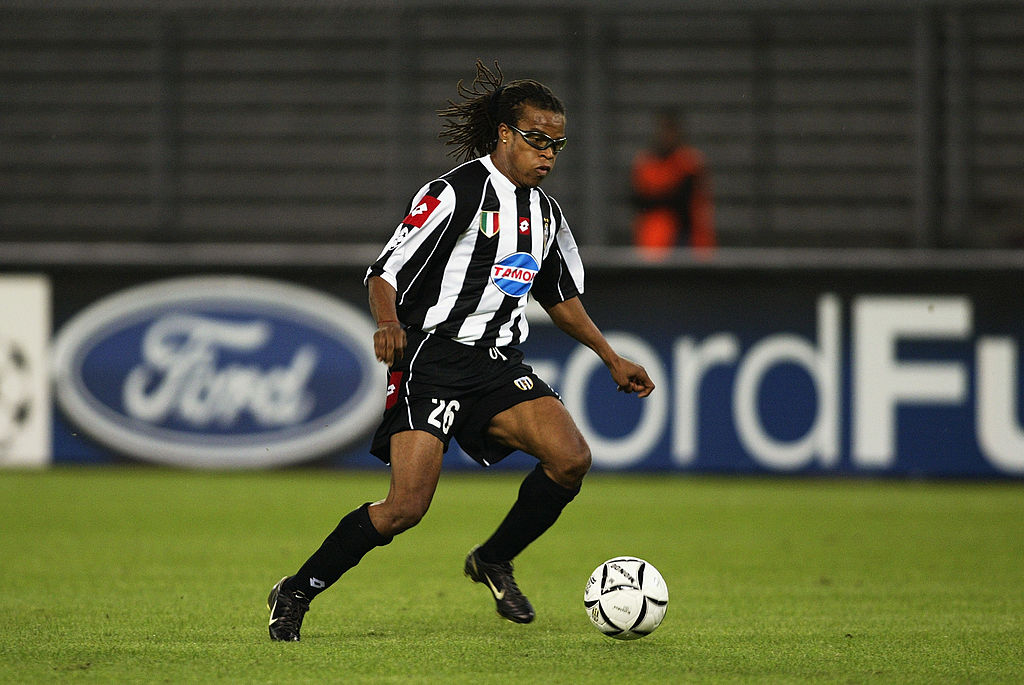
Michael Hann succeeded Tench, as fans were becoming more interested than ever in football all the way across the globe. “I remember seeing a very young Ronaldinho play at Copa America, thinking ‘That kid’s good’, calling up our writer in Brazil and saying ‘This kid Ronaldinho playing for Gremio, can you do a piece on him?’” Hann explains. “Being the first UK publication to do big pieces about him or Luis Figo was a joy.
“FourFourTwo gave me the opportunity to do incredible things – I went to Stuttgart for a Germany vs Brazil friendly, we went to Brazil’s training session the day before and I ended up standing behind the goal while Rivaldo, Ronaldo and Roberto Carlos practised free kicks, kicking it back to them when it went wide. I was Brazil’s ballboy!
“I liked some of the fun ideas we had – we were doing a feature on managers applying for jobs, so we got our writer Matt Allen to apply for every available management job in the UK.”
Sadly, Allen wasn’t handed the reins by an unsuspecting chairman. “I sent in a CV and it was all true, stuff like I had a Level Whatever coaching badge, and I’d trained with Kevin Keegan – I had done at Fulham, for a piece,” Allen says. “I applied to Chelsea and for the England job, which Keegan got – it must have been a close run thing. But I got some very nice rejection letters.
“Teddy Sheringham was my first big interview, the week after Manchester United had won the Treble, although he’d played for England since and been at fault for the goal – I turned up at his place, he picked up the post and the postman had written ‘Nice marking’ on it.
“He was a good talker and said ‘Spurs fans can’t sing that song about me any more’ – it was ‘Oh Teddy, Teddy, he went to Man United and he won f**k all’. I’m a Spurs fan and sometimes you lose sense of where you are – I said ‘Oh yes we have!’ As soon as I said it, I was like ‘Shit…’ He said ‘Oh, erm, really, what is it?’ I had to tell him fans were singing ‘Oh Teddy, Teddy, you may have won a medal but you’re still a c**t’.
“Edgar Davids was interesting too, one of my favourite players ever, although I wanted to get a shirt signed. He signed it, but before he handed it back, said ‘Have you got £5?’ I was like ‘What?’ He said ‘I did something for you, you do something for me, you’re going to put this on eBay, aren’t you?’ I had to explain I was a Spurs season ticket holder, he begrudgingly gave it back, grunted and walked off.
“I also went to Washington DC for Newcastle’s pre-season tour – Kieron Dyer lost his passport on the way home, Duncan Ferguson was getting increasingly angry he wasn’t getting picked. Bobby Robson got my name wrong every day, but me and him walked along the Vietnam Veterans Memorial, with all of the names of the soldiers, and it was very moving, the scale of the loss of life. A kid also turned up who’d been shot in the Columbine massacre and was recovering from his injuries. Bobby made a fuss of him, sat him on the team coach, took him for lunch with the players, they were just lovely with this kid.”
After Mat Snow joined as editor, having previously run music magazine Mojo, a regular feature called More Than A Game began. “Rivalries that were intense – usually derbies, but not necessarily,” he explains.
The first, naturally, was Boca Juniors vs River Plate. “It was frightening, because of the lawlessness in the Bombonera,” says Louis Massarella, who wrote for FFT for 12 years, and travelled from England for the game. “Babies in arms would be next to people doing drugs, home fans were pissing from the top tier on to the opposition fans below. When people jumped up and down, you could feel the stadium shake.”
Many more features followed, all around the world. “I did Orlando Pirates vs Kaizer Chiefs in South Africa, and when I did Hapoel Tel Aviv vs Maccabi Tel Aviv, I basically got abducted by a taxi driver,” says FFT’s current editor at large Andy Mitten, who’s been writing for the magazine since 2001.
“I flagged him down and said ‘Take me to the headquarters of Hapoel’s ultras’. He said ‘No, I hate them, I’m a fan of Beitar Jerusalem, you’re my last job before I go to their game, why don’t you come with me?’ I did, but he was mad and I had to ring my Israeli contact to tell him ‘Don’t f**k this lad around’.
“He calmed down, he was playing songs to me, saying ‘This is for our president who was killed by a suicide bomber’. Afterwards he was supposed to take me back to Tel Aviv, but said ‘Let’s go to Ashdod, near Gaza’. I was like ‘Why?’ He was offering me drugs – it was pretty hairy.”
Umpire’s chairs on Hackney Marshes
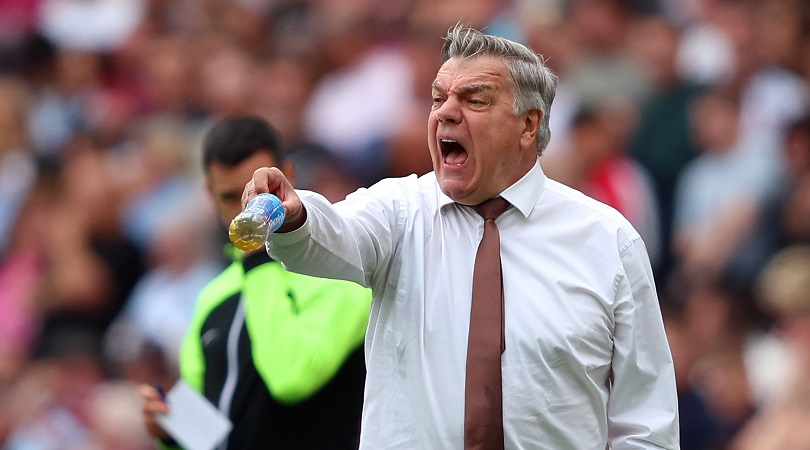
Sometimes, organising interviews with big stars was no less stressful. “The amount of time and diplomacy that went into one with David Beckham, dealing with his people, it was like trying to end the Russia-Ukraine war,” says Snow.
Entourages were increasingly becoming prevalent, although some players relied on them less than others. “Gary Neville was his own man – when I interviewed him, there were four people sat round the table, an agent, a PR person, maybe someone from the club,” Massarella remembers. “He just said ‘Do you lot need to be here? I don’t need you, to do this interview’, and sent them all out of the room. He was a grown adult, he knew he could answer my questions without needing anyone to step in and say ‘Don’t answer that’ or ‘Say this’.”
In 2003, interviews were secured with both the Brazilian Ronaldo and the emerging Cristiano Ronaldo for the same issue – entitled ‘The Two Ronnies’, of course. A year later, FourFourTwo somehow managed to forecast that Greece would win the Euros. “I’d been approached by Bethea Jenner, a professional astrologer,” Snow explains. “She ran the astrological rule over every participating nation and said ‘There’s only one winner: Greece’, which was so absurd. We ran it and it turned out to be correct – she was the only person in the entire world who called that right!”
Brian Clough was a regular columnist, from 2001 until his death in September 2004. “He was very nice to deal with – he’d phone me at home, sometimes I’d have to say ‘I’m just bathing my child’ and he was so sweet about it,” Snow says.
“After the first column or two though, we got letters from Liverpool fans saying they were upset we were carrying Brian Clough, because he’d bought into the official police version of the Hillsborough disaster. Fans showed me more and more evidence that there’d been a cover-up.
“I said to Brian that I’d really appreciate it if he could review it and, if he felt it appropriate, recant some of the things he’d said about the Liverpool fans, based on the new evidence. I said ‘I think you ought to do that anyway, because you’re a public figure and people look to you, and if you don’t want to do that, I’m not sure we can carry on with the column, it wouldn’t sit well with me’. But he did, he said in his column that he’d been wrong, that he understood that there was more evidence that showed Liverpool fans weren’t at fault.”
Stan Bowles, Michel Salgado, Diego Forlan and Lothar Matthaus have also been among FourFourTwo’s columnists over the years, as well as Sam Allardyce. “We had ‘Ask Sam’, where people would send in questions,” explains Gary Parkinson, who worked for FourFourTwo for a decade and a half. “Someone asked ‘Why do you start matches watching from the stand, then go down to the touchline?’
“He said ‘I want to get an overall view of the game’, then suggested, in all sincerity, that grass coaches should try it, maybe by getting a tennis umpire’s chair and sitting on it. I was just imagining Hackney Marshes full of blokes wheeling umpire’s chairs through six inches of mud, saying ‘Well, Sam suggested it…’”
Hugh Sleight became FourFourTwo’s longest-serving editor so far, spanning six years from 2004 to 2010, having been deputy editor when the Galacticos starred on the front cover in 2003. “It was 21 pages, we really went in depth,” Sleight says. “Sid Lowe was chasing all the Galacticos individually and asked Figo ‘Would you do this interview, do you know FourFourTwo?’ Figo leaned inside his car, picked up a magazine from the passenger seat, held it up and said ‘This?’ It was a copy of FourFourTwo.”
It’s been a common theme among footballers over the years. “Trust me, I read FourFourTwo all the time, since a long time ago,” Dimitar Berbatov told us, when we met him in 2018.
“It's always been the best magazine and it always will be,” regular reader Jamie Carragher says now. “I always wanted to be on the front cover, I made it once, and I also wanted to pick the team in the back of the magazine.”
Some players have found it tough to pick their Perfect XI, facing difficult choices over which of their friends to leave out. Not so for Carragher. “No, I’d had my team in my head for about a year, I was that desperate to do it!” he laughs. “The first ever issue, that was Terry Venables, wasn’t it? At Liverpool, I was known as the guy with the magazines – I’d take FourFourTwo on to the team coach.”
Sleight remembers a chance meeting with baseball’s king of Moneyball, at a conference in London. “Someone said ‘Billy Beane’s a big FourFourTwo fan’, then later told me ‘He wants to meet you’,” the former editor says. “He was talking to Arsene Wenger and Damien Comolli, said ‘Excuse me a minute’, came over and started chatting about FourFourTwo, saying ‘It’s the best magazine ever, so much better than anything we’ve got in the US’ – even though the US had Sports Illustrated and ESPN magazine. This guy who went on to be played by Brad Pitt in a movie was saying ours was the best sports magazine in the world.”
FFT’s standing even afforded Sleight an invitation on a press trip to Portugal for Euro 2004, so prestigious that one of the other guests was Noel Gallagher. “He always sat on the front seat of the bus – I think so fans would see him,” Sleight says.
“Diego’s playing golf? It’s 2am!”
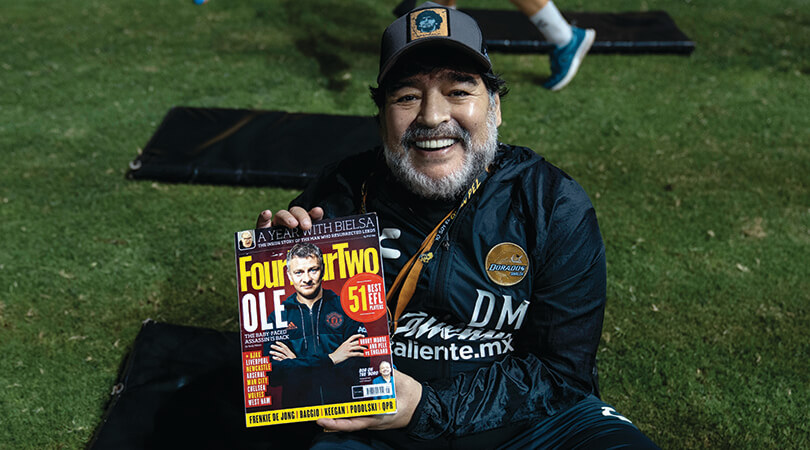
In January 2006, FFT predicted the future with a ‘Ronaldinho Introduces Messi’ cover, featuring interviews with the most recent winner of the Ballon d’Or, and the 18-year-old Argentine. “Best in the world? I’m not even the best at Barça…” said the cover line. Ronaldinho knew.
Andy Mitten did both interviews – having made his name as the founder of Manchester United fanzine United We Stand, splitting his time between England and a base in Catalonia allowed him to get the inside track on Barcelona. “I told Ronaldinho that my now wife was from his city in Brazil, Porto Alegre, and he was like ‘What the f**k, what’s she doing with you?’” Mitten laughs. “I said ‘What are you implying?’ He said ‘The girls where I’m from are good looking!’ I said ‘What are you suggesting?!’
“Then I think we got the first English language interview with Messi – he’d just got into Barcelona’s first team. Their B team captain was a friend of mine and had told me previously ‘A guy came to training for the first time today, he’s incredible – I smashed him but he just bounced up and looked at me’. I could go straight to Messi’s dad, and I got to know Messi.”
Mitten met Eric Cantona too, discussing his infamous kung-fu kick on a Crystal Palace fan. “I didn’t hit him strong enough – I should have hit him harder,” the Frenchman said.
FFT also got an interview with Diego Maradona… eventually. “Our Argentine writer Martin Mazur had a contact,” Sleight says. “Martin was trying to get hold of him, but Maradona was in Cuba, hanging out with Fidel Castro. He’d ring at 10am and a guy would say ‘Maradona’s in bed, ring back later’. He’d ring at 1pm, still in bed, 3pm the next day, still in bed, 5pm, still in bed. Finally he rings at 2am and the guy says ‘He’s out playing golf’. Martin says ‘It’s the middle of the night?’ The guy says ‘Diego’s got these night-vision goggles, he really likes them’.”
As well as chats with the legends, the magazine boasted regular feature Louis’ Weird Weekend. “That was the name of Louis Theroux’s documentaries, so someone said ‘What can we get you to do that’s weird?’” explains Louis Massarella. “I trained with cheerleaders, and I did a keepy-up challenge on the pitch at Stamford Bridge. I said to my girlfriend ‘I’ve got tickets to a match, I’ve got to do this thing at half-time’. She sat in the stands while I was getting abused by 42,000 – it was Chelsea vs Arsenal, it was the only time both sets of fans came together!
“I did two days of pre-season with Nottingham Forest and absolutely died – every part of my body ached. I also went to Nigeria with Arsenal’s women’s team – one night they were encouraged to play Nigerian instruments, and I ended up on the bongos with Alex Scott.”
Fellow writer Nick Moore got stuck into the madness, too. “I spent a week with Plymouth fans,” he says. “I went from London to Plymouth so I could travel from Plymouth to Hartlepool on a bus on the Saturday, then back to Plymouth so I could travel from Plymouth to Carlisle on the Tuesday, and write a feature about these nutty Plymouth fans, about 40 of them. Some were getting up at 1am from the edge of Devon, to get the bus with us.”
Other times, Moore was back at FFT’s Teddington HQ – the same building used to film The Office – baffling footballers with another regular interview in the magazine, Ask A Silly Question (see page 26), featuring the weirdest questions he could possibly think of.
“You’d find out whether they were a fun person or not,” Moore chuckles. “Most were, but Andy Cole hung up, and poor old Roger Hunt was very confused. Thinking of weird questions used to drive me insane. Once, I asked ‘How would you react to being given a lifesize marionette of Andre Agassi as a Christmas present?’ For a while, I’d read out a list of horse names, get them to pick one, and ring them back to tell them if it won or not. Rio Ferdinand enjoyed playing rock paper scissors down the phone, and Geoff Hurst said he’d been dreaming about being stressed about reinsuring his car – such a Geoff Hurst boring dream…”
Stranded in the Shetlands
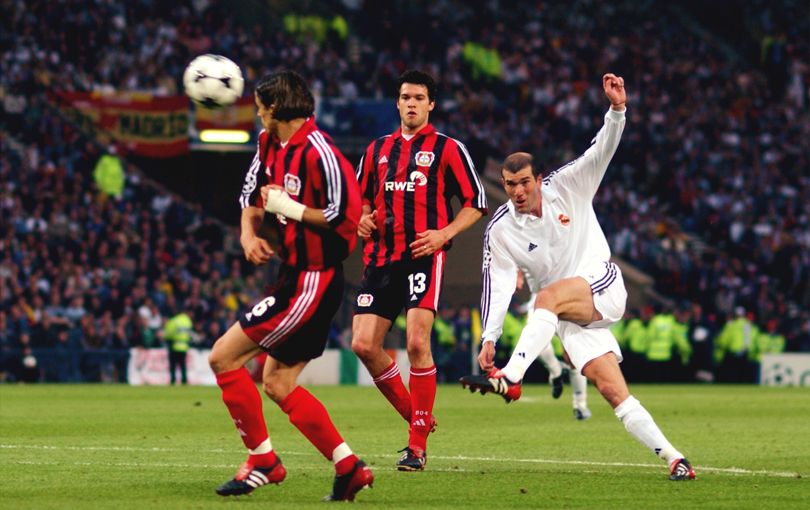
In 2010, FFT created a special Pele issue to celebrate his 70th birthday. “We had two hours with him in a hotel overlooking Hyde Park – it’s the one thing where I can say I did that, and my son says ‘My mates think that’s amazing’,” Massarella explains.
In 2013, FFT reunited the Galacticos of Zidane, Figo, Ronaldo and Roberto Carlos, 10 years after their previous cover together. “It was the most complex thing I did as editor,” says David Hall. “They’d retired and weren’t living in the same city – I even went on to eBay and bought the right Real Madrid shirts for the photoshoots! It took a year to arrange everything, but they were all up for it – they had fond memories of their time together. It was a really great feature.
“I was proud of our Borussia Dortmund cover too, in the year they got to the Champions League final against Bayern Munich. When we said we wanted to do a cover on them, Dortmund practically ripped our arms off, they were so keen to grow their international profile.
“We met them on their winter break in La Manga – Robert Lewandowski, Marco Reus, Mario Gotze, the captain Sebastian Kehl and Jurgen Klopp were all there for the photoshoot. For one picture, the photographer asked Reus if he could turn his chest more towards the camera and Klopp started shouting ‘More breast!’ They were just having a good time, which was the whole essence of that club.
“Another thing I remember is shouting at Mario Balotelli, when we did a shoot with him. We wanted a design with two Balotellis on the page – one really angry and shouting, and one looking scared of the other one. He didn’t get the concept of the shouting, so I said ‘Do this’, shouted at him, then he shouted back at me!”
In 2015, Hitesh Ratna became FourFourTwo’s first editor of Asian descent. “It was a dream job, and for someone of my background, there weren’t that many people in that line of work in sports media,” he says.
“Before that, I’d been staff writer – I went to the Faroe Islands with a bunch of Man City fans for a UEFA Cup qualifier in 2008. We got the overnight ferry to the Shetlands, then their plan was to get a fishing trawler to the Faroes, but the seas were too rough and we got stuck in the Shetlands. The lads were lairy and I was thinking ‘Get me out of here…’ But Sky ran a story on these lads being stuck, the CEO of the Faroese national airline saw it and chartered a flight for us. It ended up being part nightmare, part adventure.
“The cover I’m most proud of was when Ronaldo was guest editor, for the 20th anniversary – he was contracted to a Brazilian TV station, but made them give him a special exemption because he liked doing new things. We wanted to make it look like an anniversary cover, so the night beforehand, I asked the photographer if he could get a party hat and party blower, in Brazilian colours. He said ‘So you want me to go out and find green and yellow party hats and party blowers… for tomorrow morning?!’
“I’d also asked if Ronaldo had anything smart he could wear for the cover, but he turned up wearing T-shirt, shorts and flip flops. Midway through the interview though, he disappeared upstairs, and came back wearing a tuxedo. It was Ronaldo, it was the 20th anniversary issue, he was in a tux, with a green and yellow party hat and party blower, and when the pictures were taken, I thought ‘F**k, these are amazing’. It all came together.”
In 2017, Messi was guest editor for an issue. “It took a long time to arrange, but the fact he agreed was great – we made a documentary to accompany it for YouTube,” Ratna explains.
There were more big name cover interviews, too – staff writer Andrew Murray chatted with Neymar, while features editor James Maw spoke to Harry Kane, weeks after the first England appearance of what has since become a record-breaking international career. FFT jetted to Los Angeles to speak to Zlatan Ibrahimovic, and a 19-year-old Kylian Mbappe became the magazine’s cover star, shortly before winning the 2018 World Cup.
“I’d arranged everything, we arrived with our photographer, and we had everything set up for the shoot,” Ratna says. “Then 10 minutes beforehand, we were told that Kylian had his own personal photographer and we had to use him instead, it was non-negotiable.
“We were like ‘What?’ – they were saying they’d take pictures in the middle of PSG’s canteen or something, but for cover photos you need a whole setup and lighting, which we’d brought with us. I don’t speak French, so I was trying to do this negotiation via translation – Mbappe’s mum was on the phone with his agent.
“Mbappe was on the rise and his family were dealing with what it meant to be a global superstar, trying to protect his interests, but they must have got some bad advice from someone, that he should have a personal photographer for everything.
“Mbappe strolled past and started tapping his watch, telling everyone to hurry up, because he had to go to training soon. He didn’t care about the photo situation, he was like ‘You all sort this out, and tell me when you need me’. Thankfully they relented.”
Santa Claus: no fan of Trump
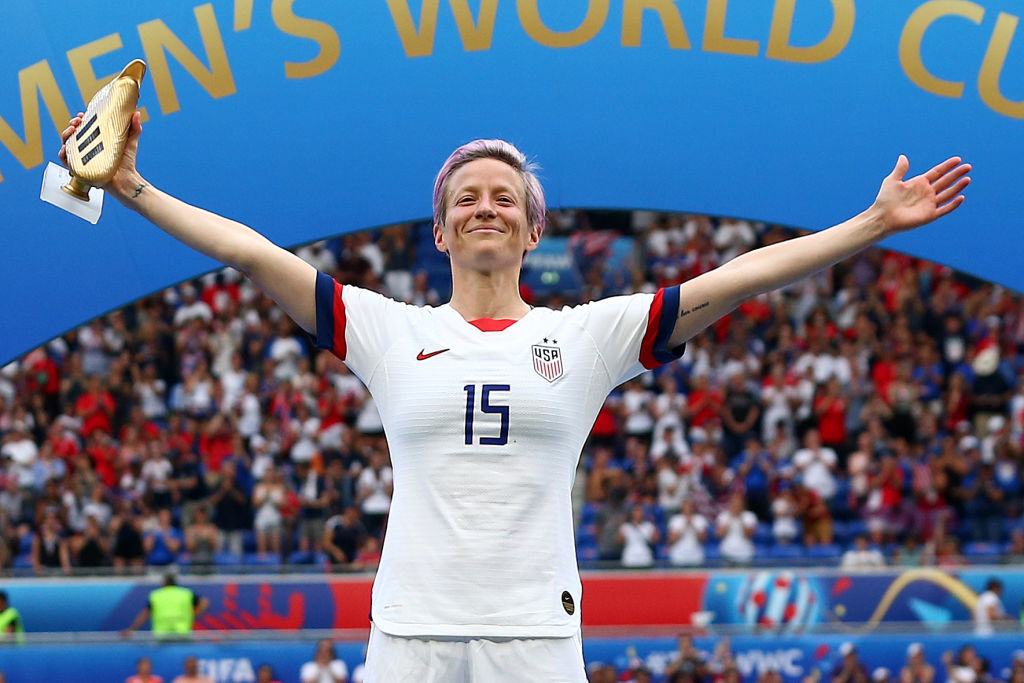
Three years before England won Euro 2022, FourFourTwo dedicated a special issue to the Lionesses ahead of the 2019 World Cup, also interviewing numerous major female stars in recent years, including Megan Rapinoe on her public spat with Donald Trump. “I don’t care what Trump thinks about me – he likes to think the world revolves around him, but it really doesn’t,” she told us.
On the morning after Trump was elected president in late 2016, FFT happened to be in Lapland for a feature about Finnish club FC Santa Claus, interviewing Santa at his grotto.
Even Father Christmas aimed a dig at America’s new supremo. “A lot of people have been successful, but do not even ask me if they have been good,” he said, when asked about his football club’s lack of success on the pitch. Obviously a Hillary Clinton fan.
Before their deaths, two of football’s biggest legends also did final interviews with FFT. “We got both Pele and Maradona,” Loaded founder James Brown says of his spell as FourFourTwo editor – we revisit Andy Mitten’s trip to Mexico to meet Maradona on page 58 of this issue. “I loved working for FourFourTwo – when I saw the job advertised, I thought ‘I want to do that’. I remember when it first launched, thinking how great it was, like Empire with films – in-depth, well-written, interesting features, a lot of things about football culture rather than just players. Great magazines have people who live and breathe the job, who make readers want to be writers, and FourFourTwo has always had that.”
In recent years, as well as greats such as Arsene Wenger, football’s new big superstars like Erling Haaland and Jude Bellingham have sat down for extended interviews – over the past three decades, FFT has spoken to pretty much every legend of the game you could possibly imagine.
“There’s been an amazing roll call of greats, which would have astonished me in that room for that first editorial meeting we had, back in 1994,” says the magazine’s launch editor Paul Simpson. “And there’s still a personality in the magazine that harks back to what we did, the same spirit.”
As is an occupational hazard, we may have inadvertently annoyed one or two footballers over the years, mind. Thibaut Courtois took umbrage at being omitted from a list of the top 10 goalkeepers in the world in early 2022, used it as motivation to produce the best form of his life and help Real Madrid win the Champions League in the remaining weeks of the season, then referenced our list, mere minutes after a man-of-the-match display in the final in Paris. “There was a magazine that didn’t put me in the top 10,” he said – we apologise to Liverpool for costing them a seventh European title…
Thankfully, Carragher forgives us. “I still love FourFourTwo – I get the issues now on my iPad,” he says. “I love You Ask The Questions, with the fans’ questions, I like the interview with the celebrity fan (My Football), and also the one where fans pick their best and worst XIs (Best & Worst). That gives you a great insight into what fans thought of players at those clubs.
“I remember reading a good thing on Enzo Maresca in the magazine recently, and I learned things from the feature on Holland 1974. I didn’t know Rinus Michels came in as manager so late before that 1974 World Cup, and what I really found interesting was for the Cruyff turn against Sweden, they didn’t actually win the game, they drew 0-0… It’s all good stuff, keep it coming!”
From its origins in a pub conversation in Teddington, FourFourTwo is now sold around the world, and has had translated editions in a wide range of countries, from Turkey to South Korea, as well as overseas versions of the FFT website, too. In addition to the magazine and FourFourTwo.com, today it reaches millions more via its accounts on YouTube, Facebook, X, Instagram and TikTok.
‘It just gives me a warm glow that it’s grown into all these different things, that it has such a reach around the world,” says Karen Buchanan, the person whose idea led to FourFourTwo’s creation. “A few years ago I was in Sarajevo and saw copies of it on sale – I thought ‘Bloody hell, I made that happen’.
“Just a couple of months ago, I was hosting a Q&A event with a former player at Norwich City – a young lad of 13 or 14 asked some brilliant, well-researched questions, I told him I was really impressed, then later he came up to me with his mum. She said ‘Sorry to bother you, but he’s just found out that you started FourFourTwo, it’s his favourite magazine’. It’s lovely to have that kind of impact.”
Amy Lawrence shares Buchanan’s sentiments. “I just feel incredibly proud to have been part of that launch team – it was so thrilling to be part of something ground-breaking,” she says now. “If I close my eyes, I can still see the office and where I sat – it’s ridiculous to think it was 30 years ago. It really was such a happy time. Writing for FourFourTwo was just so much fun.”
Thirty years later, it still is.
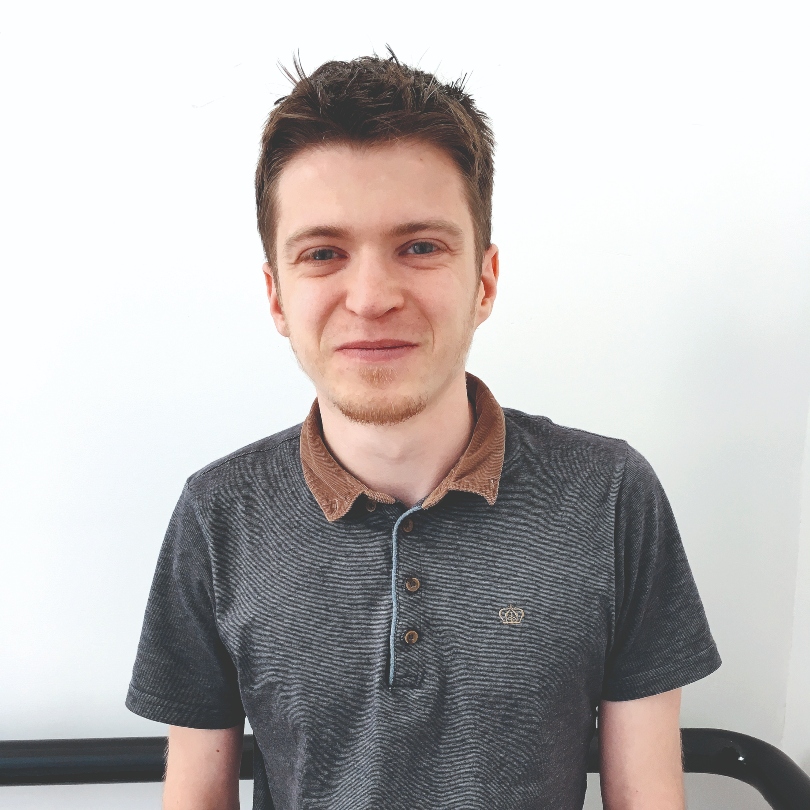
Chris joined FourFourTwo in 2015 and has reported from 20 countries, in places as varied as Jerusalem and the Arctic Circle. He's interviewed Pele, Zlatan and Santa Claus (it's a long story), as well as covering the World Cup, Euro 2020 and the Clasico. He previously spent 10 years as a newspaper journalist, and completed the 92 in 2017.
